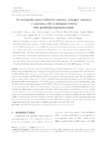Please use this identifier to cite or link to this item:
http://www.alice.cnptia.embrapa.br/alice/handle/doc/979485| Title: | An ecologically-based method for selecting ecological indicators for assessing risks to biological diversity from genetically-engineered plants. |
| Authors: | ANDOW, D. A.  LOVEI, G. L.   ARPAIA, S.   WILSON, L.   FONTES, E. M. G.   HILBECK, A.   LANG, A.   TUAT, N. V.   PIRES, C. S. S.   SUJII, E. R.   ZWAHLEN, C.   BIRCH, A. N. E.   CAPALBO, D. M. F.   PRESCOTT, K.   OMOTO, C.   ZEILINGER, A. R.   |
| Affiliation: | D. A. ANDOW, University of Minnesota; GABOR L. LOVEI, Aarhus University; SALVATORE ARPAIA, ENEA-Research Centre Trisaia; LEWIS WILSON, CSIRO Cotton Research; ELIANA MARIA GOUVEIA FONTES, CENARGEN; ANGELICA HILBECK, Swiss Federal Institute of Technology; ANDREAS LANG, University of Basel; NGUYEN VAN TUAT, Food Crops Research Institute; CARMEN SILVIA SOARES PIRES, CENARGEN; EDISON RYOITI SUJII, CENARGEN; CLAUDIA ZWAHLEN, University of Minnesota; A. N. E. BIRCH, Ecological Science Group; DEISE MARIA FONTANA CAPALBO, CNPMA; KRISTINA PRESCOTT, University of Minnesota; CELSO OMOTO, ESALQ-USP; ADAM R. ZEILINGER, University of Minnesota. |
| Date Issued: | 2013 |
| Citation: | Journal of Biosafety, v. 22, n. 3, p. 141-156, 2013. |
| Description: | The environmental risks associated with genetically-engineered (GE) organisms have been controversial, and so have the models for the assessment of these risks. We propose an ecologically-based environmental risk assessment (ERA) model that follows the 1998 USEPA guidelines, focusing on potential adverse effects to biological diversity. The approach starts by (1) identifying the local environmental values so the ERA addresses specific concerns associated with local biological diversity. The model simplifies the indicator endpoint selection problem by (2) classifying biological diversity into ecological functional groups and selecting those that deliver the identified environmental values. (3) All of the species or ecosystem processes related to the selected functional groups are identified and (4) multi-criteria decision analysis (MCDA) is used to rank the indicator endpoint entities, which may be species or ecological processes. MCDA focuses on those species and processes that are critical for the identified ecological functions and are likely to be highly exposed to the GE organism. The highest ranked indicator entities are selected for the next step. (5) Relevant risk hypotheses are identified. Knowledge about the specific transgene and its possible environmental effects in other countries can be used to assist development of risk hypotheses. (6) The risk hypotheses are ranked using MCDA with criteria related to the severity of the potential risk. The model emphasizes transparent, expert-driven, ecologically-based decision-making and provides formal methods for completing a screening level-ERA that can focus ERA on the most significant concerns. The process requires substantial human input but the human capital is available in most countries and regions of the world. |
| Thesagro: | Planta transgênica Impacto ambiental Biodiversidade |
| NAL Thesaurus: | Transgenic plants Risk assessment Biodiversity ecosystem services |
| Keywords: | Genetically engineered organisms Environmental risk assessment |
| Type of Material: | Artigo de periódico |
| Access: | openAccess |
| Appears in Collections: | Artigo em periódico indexado (CNPMA)  |
Files in This Item:
| File | Description | Size | Format | |
|---|---|---|---|---|
| 2013AP47.pdf | 4.68 MB | Adobe PDF |  View/Open |









